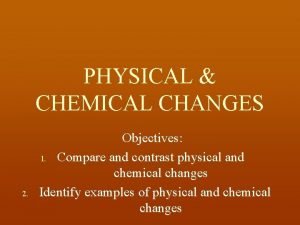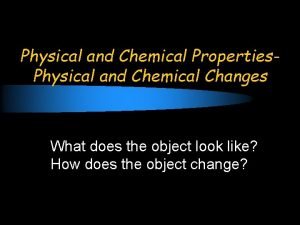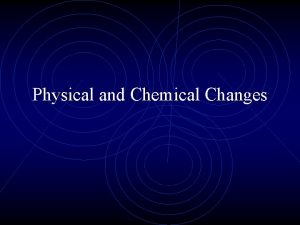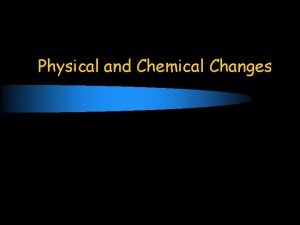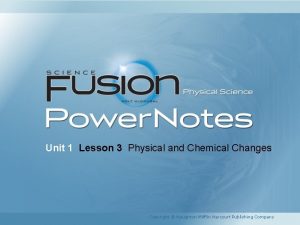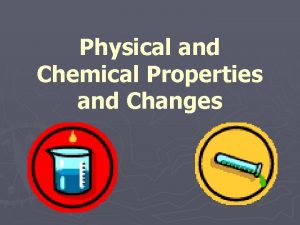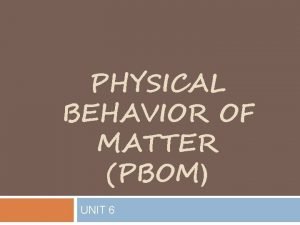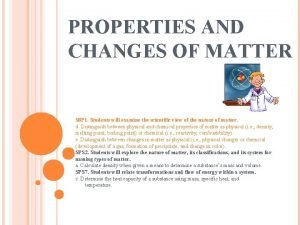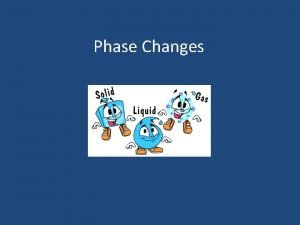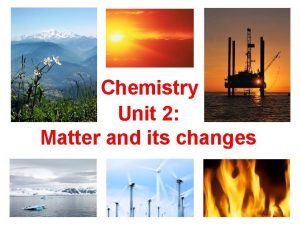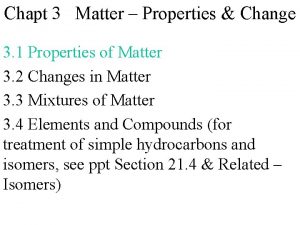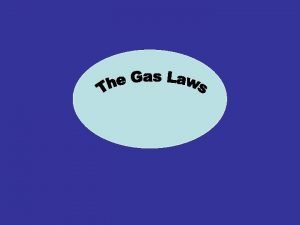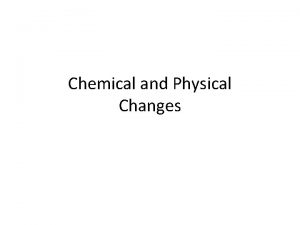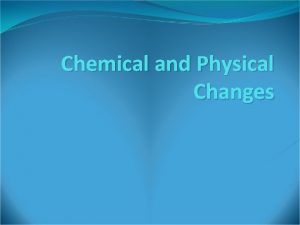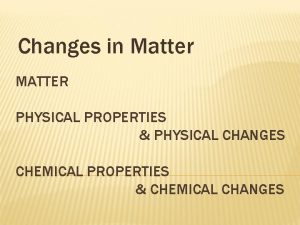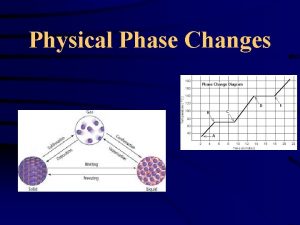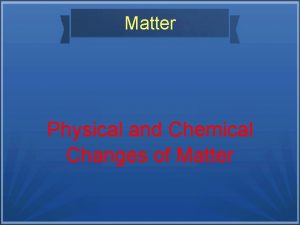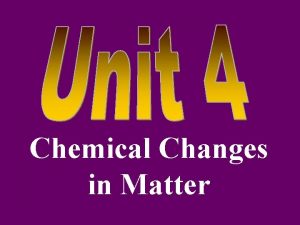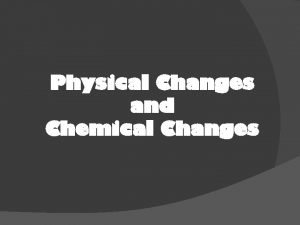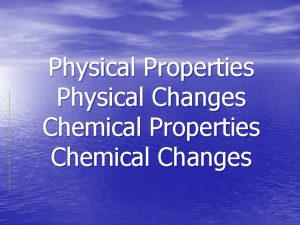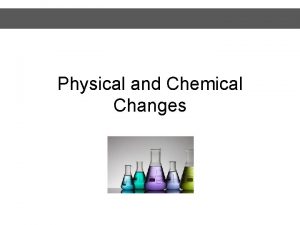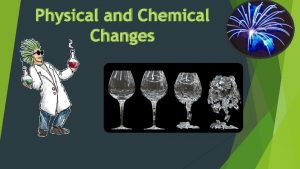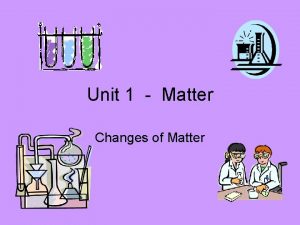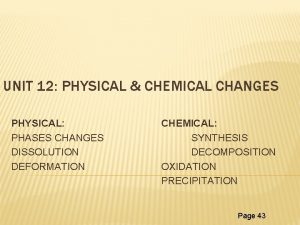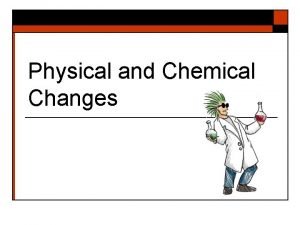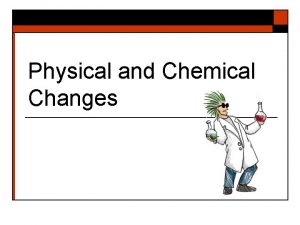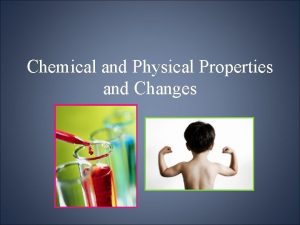UNIT 3 TRANSFORMATIONS OF MATTER PHYSICAL CHANGES CHEMICAL


































- Slides: 34

UNIT 3 – TRANSFORMATIONS OF MATTER • • PHYSICAL CHANGES CHEMICAL CHANGES LAW OF CONSERVATION OF MASS PURE SUBSTANCES & MIXTURES

PHYSICAL CHANGES � Physical change: A transformation which does not affect the particles of a substance � The particles of the substance are the same. It is only the appearance of the substance which changes. Ex. The water is always formed of water particles in the solid state (ice) , liquid ( water glass) or gas ( water vapor) � The physical changes are reversible. The substance may return to its initial state. Ex. The ice becomes liquid water when it melts

PHYSICAL CHANGES �State changes of matter are physical changes � The changes of state of matter include: Fusion (melting) Freezing Evaporation (boiling) Condensation Sublimation Deposition (solidification) solid to liquid to solid liquid to gas to liquid solid to gas to solid

PHYSICAL CHANGES: Reversable Transformations

PHYSICAL CHANGES: THE PARTICLE THEORY � The particle theory can help us understand the state changes. � Scientists use the particle theory to explain the structure of matter: � 1 -Any substance is made of small particles. � 2 - A substance is composed of same or different particle. � 3 - There is space between the particles. � 4 - The particles are always moving – These movements are more or less rapid depending on the temperature of the substance. � 5 - The particles of a substance attract ( pull ) or repel ( repulsion ) one another - The strength depends on the type of particles

PHYSICAL CHANGES: THE PARTICLE THEORY �Take a solid ( A) � The particles can only vibrate. When the solid is heated , the temperature increases because the particles vibrate more and stronger and faster.

PHYSICAL CHANGES: THE PARTICLE THEORY �The melting point (B) � The particles will vibrate so strongly that the links between them will turn The solid at its melting point and gradually turns into liquid. � The plateau in the graph is called the melting bearing.

PHYSICAL CHANGES: THE PARTICLE THEORY �The substance has now become a liquid ( C) � The particles can move slightly. � When heating the liquid , the particles will move more freely and more quickly

PHYSICAL CHANGES: THE PARTICLE THEORY �The boiling point (D) � The particles are moving so fast and so hard that the links between them will break. � The liquid reaches its boiling point and becomes gas. � The plateau in the graph is called the boiling stage

PHYSICAL CHANGES: THE PARTICLE THEORY �The substance has now become a gas ( E) � The particles rapidly disperse in all directions

CHEMICAL CHANGES: Radical Transformations �Chemical change: a transformation in which new substances are formed with their own properties. �Ex. Burning paper – Ash and carbon dioxide are formed. The paper is white, but the ash is gray. The paper is solid, but the carbon dioxide is a gas. Can not recombine the ash and the carbon dioxide to form again the paper (non-reversible)

CHEMICAL CHANGES: Radical Transformations � 4 clues that allow us to conclude that there was a chemical change: 1. Formation of a gas 2. Formation of a residue Ex. - Baking bread - Stalagmites & Stalactites 3. The production of heat of light - Fireworks 4. Change of colour - Rust

LAW OF CONSERVATION OF MASS nothing is lost – nothing is created � Antoine Laurent Lavoisier, a French scientist of the 18 th century, performed many experiments on the transformations of matter � Lavoisier saw that the mass of substances that are transformed is always equal to the mass of the substances that come out of the transformation. � He called this phenomenon: The Law of Conservation of Mass – “Nothing is lost, nothing is created, everything is transformed. ”

LAW OF CONSERVATION OF MASS nothing is lost – nothing is created �From melting ice (physical change) to liquid. 1 - Put ice in a closed container and take the weight of the container. 2 - Heat the ice on a hot plate. 3 - Take the mass of container with liquid water. The mass remains the same before and after transformation.

LAW OF CONSERVATION OF MASS nothing is lost – nothing is created

PURE SUBSTANCES & MIXTURES �Pure substance: Contains only one kind of particle. Ex. The salt, sugar, distilled water. � Mixture: Contains at least two kinds of particles. Ex. The air, the sand at the beach, distilled water , etc.

PURE SUBSTANCES & MIXTURES PURE SUBSTANCE DISTILLED WATER (H₂O) MIXTURE SALT WATER (H₂O + Na. Cl)

MIXTURES – HETEROGENOUS or HOMOGENOUS MATTER PURE SUBSTANCES MIXTURES HOMOGENOUS Contains only one type of particle. Ex. Water, iron, Salt Composed of atleast 2 types of particles Properties are uniform To the naked eye it looks like only ONE substance Ex. Salt water, Loonie HETEROGENOUS Composed of atleast 2 types of particles Properties are not uniform To the naked eye you can tell that there are different substances Ex. Smog, Twoonie

MIXTURES – HETEROGENOUS or HOMOGENOUS �Homogeneous mixture (solution): A mixture in which one can not distinguish the different kinds of particles. Ex. The air (Air is a mixture of gases, but you can not distinguish gases from each other ) - It looks like a pure substance. �Heterogeneous mixture : a mixture in which one can distinguish the different kinds of particles. Ex. Smog ( The pollutants in the air are visible as gray cloud)

MIXTURES – HETEROGENOUS or HOMOGENOUS

MIXTURES – HETEROGENOUS or HOMOGENOUS �In a Solution (homogeneous mixture) as sugared water, the solute particles are uniformly distributed among the particles of the solvent. �Solute: The part of a mixture which is dissolved (ex. sugar). You can have several solutes. �Solvent: The part of a mixture that dissolves other substances (ex. water). There is only a solvent in a solution.

MIXTURES – HETEROGENOUS or HOMOGENOUS SOLUTION HOMOGENOUS MIXTURE SALT (SOLUTE) WATER (SOLVENT) SALT WATER (SOLUTION)

MIXTURES – HETEROGENOUS or HOMOGENOUS SALT PARTICLE (solute) WATER PARTICLE (solvent)

MIXTURES – HETEROGENOUS or HOMOGENOUS MIXTURE Salt & Water MIXTURE Sugar & Water MIXTURE Copper Sulfate & Water MIXTURE Sand & Water HOMOGENOUS HETEROGENOUS MIXTURE Mud & Water HETEROGENOUS

MIXTURES – HETEROGENOUS or HOMOGENOUS �Dissolution: When two or more substances are mixed to form a solution. The solvent dissolves the solute. Ex. Hot Chocolate – (Solvent) Hot water dissolves (Solutes) Chocolate Powder, Milk, Marshmallows, Whipped Cream.

SEPERATION OF MIXTURES �Some techniques used for the separation of mixtures include: 1 – Sedimentation 2 – Decanting 3 – Filtration 4 – Distillation

SEPERATION OF MIXTURES SEDIMENTATION �Sedimentation: After some time, the particles of a heterogeneous mixture will separate. The heavier particles settle to the bottom of the container where they form a sediment Ex. Muddy water - The solids (heavier) settles to the bottom of the beaker and form a sediment.

SEPERATION OF MIXTURES SEDIMENTATION Sedimentation technique takes time • Ex. Orange juice - The pulp settles to the bottom of the container. • Ex. Salad Dressing - The vineger and oil separates and particles settle to the bottom of the container.

SEPERATION OF MIXTURES DECANTATION �Decanting: Often used after sedimentation. Decanting separates the layers of a heterogeneous mixture in various containers. Ex. Muddy water - We can pour the water into another container leaving the sediment in the original container.

SEPERATION OF MIXTURES DECANTATION A GLASS ROD A SEPARATORY FUNNEL

SEPERATION OF MIXTURES FILTRATION �Filtration: Used to separate the different substances of a heterogeneous mixture. It can replace sedimentation and decanting. During filtration, a mixture is passed through a filter paper which is perforated with many small holes. The paper retains the larger particles (the residue) and the hole let in the smaller (filtrate). Ex. Coffee machines – keeps the grinds out and lets the water seep through into the cup

SEPERATION OF MIXTURES FILTRATION Ex. Muddy water - Water (filtrate) will pass through the holes of the filter paper and the solid parts (the residue) will remain in the filter paper

SEPERATION OF MIXTURES DISTILLATION � Distillation: Filtration can separate the different substances a homogeneous mixture ( solution ) using their boiling points. Ex. The salt water - We start with warm salt water. When the temperature reached 100 ° C , water boils and is converted into steam. In the tube called the condenser, the steam cools and returns to the liquid state (condensation). Liquid water ( distillate ) accumulates in the beaker and there remains only the salt (the residue) in the flask.

SEPERATION OF MIXTURES DISTILLATION �BOILING POINTS: WATER 100 °C SALT 1, 413 °C
 Physical changes vs chemical changes
Physical changes vs chemical changes True or false: chemical and physical changes alter matter.
True or false: chemical and physical changes alter matter. Changes of matter examples
Changes of matter examples Section 1 chemical changes
Section 1 chemical changes Physical change
Physical change Physical change
Physical change Physical and chemical changes
Physical and chemical changes Is sawing wood a chemical change
Is sawing wood a chemical change Generation genius physical and chemical changes
Generation genius physical and chemical changes Wadding up paper
Wadding up paper Chemical change and physical change
Chemical change and physical change Difference between chemical and physical property
Difference between chemical and physical property Which is true about chemical change
Which is true about chemical change Whats the difference between a chemical and physical change
Whats the difference between a chemical and physical change Physical and chemical changes jeopardy
Physical and chemical changes jeopardy An example of a physical change
An example of a physical change Chemical change
Chemical change Lesson 3 physical and chemical changes answers
Lesson 3 physical and chemical changes answers Physical/chemical changes & properties color by number
Physical/chemical changes & properties color by number Chemical properties of fire
Chemical properties of fire The science duo physical and chemical changes
The science duo physical and chemical changes Changes in latitudes, changes in attitudes meaning
Changes in latitudes, changes in attitudes meaning Physical behavior of matter
Physical behavior of matter Properties and changes of matter worksheet
Properties and changes of matter worksheet 5 phases of matter
5 phases of matter Chemistry matter and its changes
Chemistry matter and its changes Matter-properties and changes answer key
Matter-properties and changes answer key Change in state of matter
Change in state of matter Two types of changes in matter
Two types of changes in matter Which is a “big idea” for matter and change?
Which is a “big idea” for matter and change? Diffusion vs effusion
Diffusion vs effusion Phase change descriptions
Phase change descriptions Phase change concept map
Phase change concept map Pixl knowit gcse chemistry quantitative
Pixl knowit gcse chemistry quantitative What are five chemical changes
What are five chemical changes





